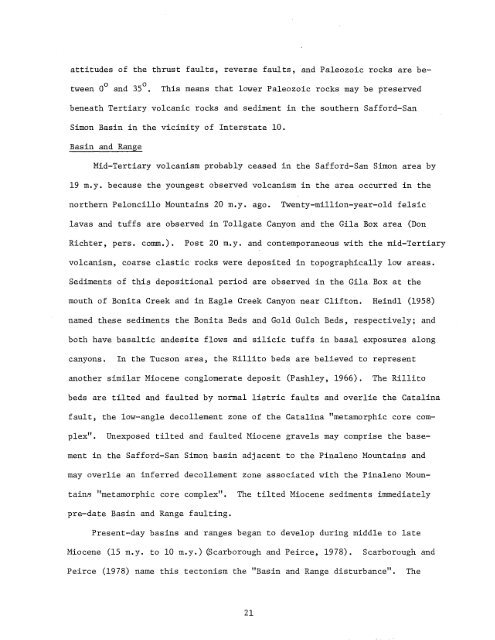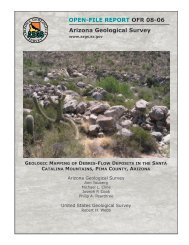geothermal resource potential of the safford-san simon basin, arizona
geothermal resource potential of the safford-san simon basin, arizona
geothermal resource potential of the safford-san simon basin, arizona
Create successful ePaper yourself
Turn your PDF publications into a flip-book with our unique Google optimized e-Paper software.
attitudes <strong>of</strong> <strong>the</strong> thrust faults, reverse faults, and Paleozoic rocks are beo<br />
0<br />
tween 0 and 35. This means that lower Paleozoic rocks may be preserved<br />
beneath Tertiary volcanic rocks and sediment in <strong>the</strong> sou<strong>the</strong>rn Safford-San<br />
Simon Basin in <strong>the</strong> vicinity <strong>of</strong> Interstate 10.<br />
Basin and Range<br />
Mid-Tertiary volcanism probably ceased in <strong>the</strong> Safford-San Simon area by<br />
19 m.y. because <strong>the</strong> youngest observed volcanism in <strong>the</strong> area occurred in <strong>the</strong><br />
nor<strong>the</strong>rn Peloncillo Mountains 20 m.y. ago.<br />
Twenty-million-year-old felsic<br />
lavas and tuffs are observed in Tollgate Canyon and <strong>the</strong> Gila Box area (Don<br />
Richter, pers. comm.). Post 20 m.y. and contemporaneous with <strong>the</strong> mid-Tertiary<br />
volcanism, coarse clastic rocks were deposited in topographically low areas.<br />
Sediments <strong>of</strong> this depositional period are observed in <strong>the</strong> Gila Box at <strong>the</strong><br />
mouth <strong>of</strong> Bonita Creek and in Eagle Creek Canyon near Clifton. Heindl (1958)<br />
named <strong>the</strong>se sediments <strong>the</strong> Bonita Beds and Gold Gulch Beds, respectively; and<br />
both have basaltic andesite flows and silicic tuffs in basal exposures along<br />
canyons.<br />
In <strong>the</strong> Tucson area, <strong>the</strong> Rillito beds are believed to represent<br />
ano<strong>the</strong>r similar Miocene conglomerate deposit (Pashley, 1966).<br />
The Rillito<br />
beds are tilted and faulted by normal listric faults and overlie <strong>the</strong> Catalina<br />
fault, <strong>the</strong> low-angle decollement zone <strong>of</strong> <strong>the</strong> Catalina "metamorphic core complex".<br />
Unexposed tilted and faulted Miocene gravels may comprise <strong>the</strong> basement<br />
in <strong>the</strong> Safford-San Simon <strong>basin</strong> adjacent to <strong>the</strong> Pinaleno Mountains and<br />
may overlie an inferred decollement zone associated with <strong>the</strong> Pinaleno Mountains<br />
"metamorphic core complex".<br />
The tilted Miocene sediments immediately<br />
pre-date Basin and Range faulting.<br />
Present-day <strong>basin</strong>s and ranges began to develop during middle to late<br />
Miocene (15 m.y. to 10 m.y.) $carborough and Peirce, 1978). Scarborough and<br />
Peirce (1978) name this tectonism <strong>the</strong> "Basin and Range disturbance".<br />
The<br />
21

















